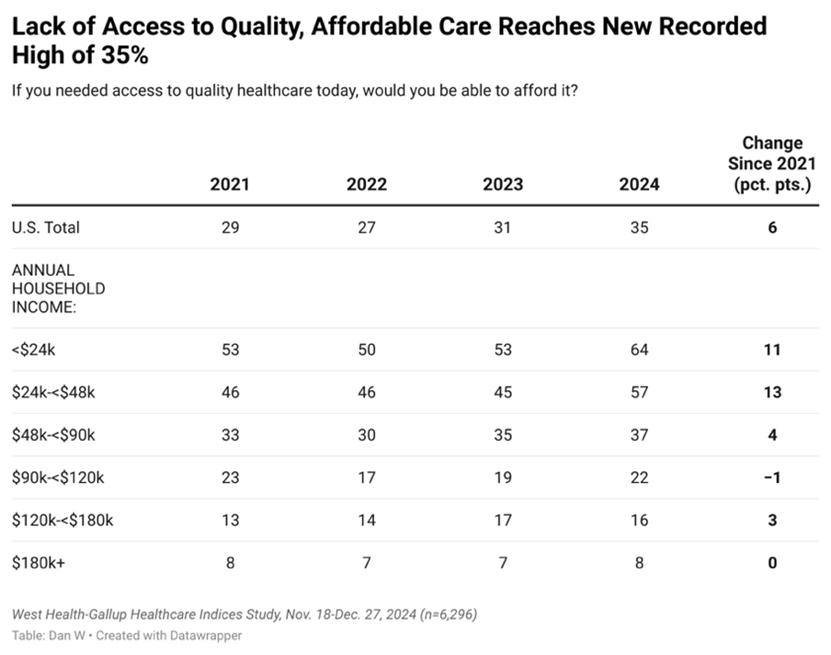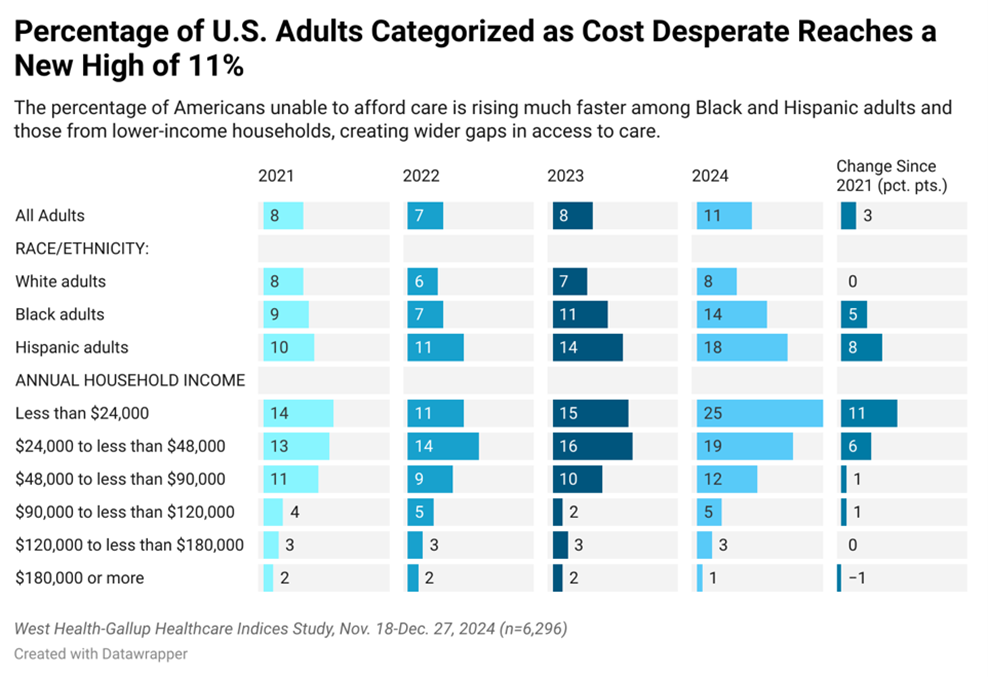Inability to Pay for Healthcare Reaches Record High in U.S.
WASHINGTON, D.C. – April 2, 2025 – The inability to pay for healthcare in the U.S. has reached a new high, with more than one-third of Americans (35%), or an estimated 91 million people, reporting that they could not access quality healthcare if they needed it today, according to the latest West Health-Gallup Healthcare Affordability Index. The Index has been tracking healthcare affordability and access in the U.S. since 2021.
Rates were higher among Black and Hispanic Americans, with 46% and 52%, respectively, reporting that they would be unable to afford quality healthcare. Americans in higher-income households remained relatively stable in their ability to access affordable care, but the rate of unaffordability increased significantly among lower-income households. About two-thirds (64%) of people earning less than $24,000 and 57% of households with annual incomes between $24,000 and $48,000 reported difficulties with affordability, an 11- and 12-point increase from 2023, respectively.

“The rising trajectory in the inability to pay for healthcare is a disturbing trend that is likely to continue and even accelerate,” said Tim Lash, president of West Health Policy Center, part of a group of nonprofit organizations focused on healthcare and aging. “Policy action at both the state and federal level is urgently needed, or even more Americans will have to go without treatment or be forced to make painful tradeoffs between paying for medical care or paying for other necessities. The human and economic costs are enormous.”
The West Health-Gallup Healthcare Affordability Index categorizes Americans into one of three groups:
- Cost Secure: faced no recent difficulty accessing or affording care or paying for prescription medicine
- Cost Insecure: recently unable to access care or afford either care or prescription medicine
- Cost Desperate: recently unable to access care and afford care and prescription medicine
Based on these criteria, just over half of Americans (51%) are considered Cost Secure, the lowest level since 2021. Hispanic adults saw the greatest declines in security over the four-year period, dropping 17 points to 34%, followed by Black adults, who dropped 13 points to 41%. Overall, about 29 million Americans, or 11% of U.S. adults, are classified as Cost Desperate, a record high.
The healthcare affordability gap has widened since 2021, particularly among Hispanic adults (up eight points to 18%), Black adults (up five points to 14%) and lower-income households earning under $24,000 per year (up 11 points to 25%), while there was little to no change in status among White adults or Americans in middle- to high-income households. The percentage of Americans age 65 and above who moved into the Cost Desperate category edged up just one point to 4%, while rising three points to 11% among those aged 50-64, and four points for people 50 and under (now 14%).

“Healthcare affordability and access continue to erode nationally, and this issue is especially acute among Black, Hispanic, and lower-income adults. White adults and those in higher-income households, in contrast, remain largely insulated from these worsening trends,” said Dan Witters, senior researcher at Gallup. “Among these groups, this is the widest gap in access to care we have recorded thus far, with many Americans experiencing increased hardship year over year.”
Methodology
The West Health-Gallup Healthcare Indices Survey was conducted by web and mail Nov. 18-Dec. 27, 2024, with 6,296 adults aged 18 and older living in all 50 U.S. states and the District of Columbia as a part of the Gallup Panel™. For results based on the full sample, the margin of sampling error at the 95% confidence level is ±1.6 percentage points for response percentages around 50% and ±1.0 percentage points for response percentages around 10% or 90%, design effect included. Reported sub-groups will have a larger margin of error, typically ±3 to 5 percentage points.
About West Health
Solely funded by philanthropists Gary and Mary West, West Health is a family of nonprofit and nonpartisan organizations including the Gary and Mary West Foundation and Gary and Mary West Health Institute in San Diego, and the Gary and Mary West Health Policy Center in Washington, D.C. West Health is dedicated to lowering healthcare costs to enable seniors to successfully age in place with access to high-quality, affordable health and support services that preserve and protect their dignity, quality of life and independence. Learn more at westhealth.org and follow @westhealth.
About Gallup
Gallup delivers analytics and advice to help leaders and organizations solve their most pressing problems. Combining more than 80 years of experience with its global reach, Gallup knows more about the attitudes and behaviors of employees, customers, students and citizens than any other organization in the world.
###


